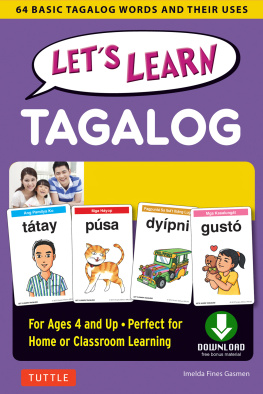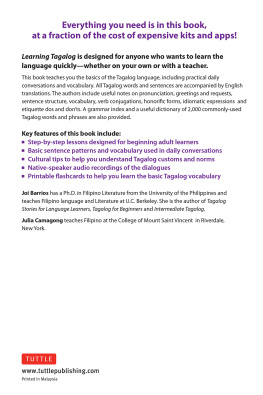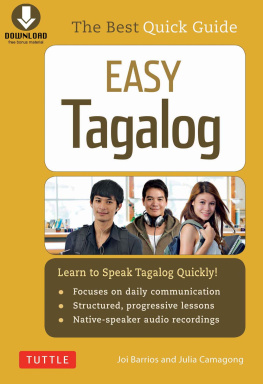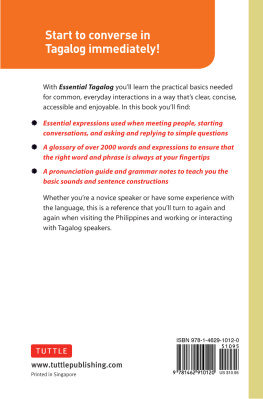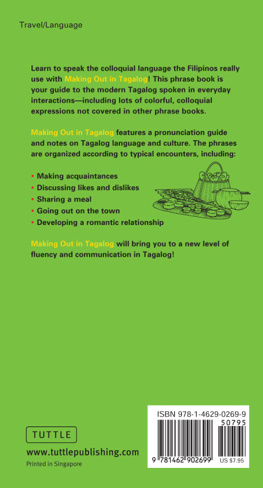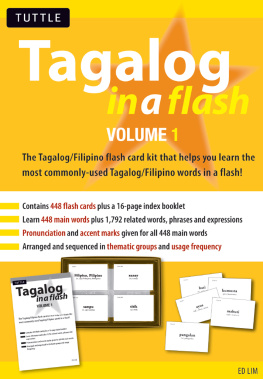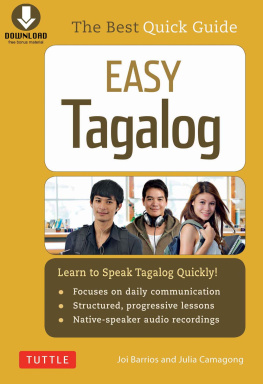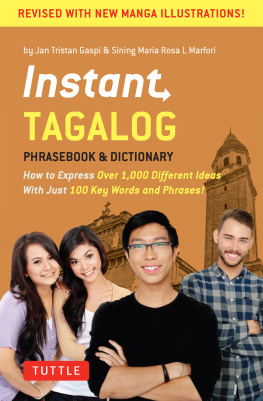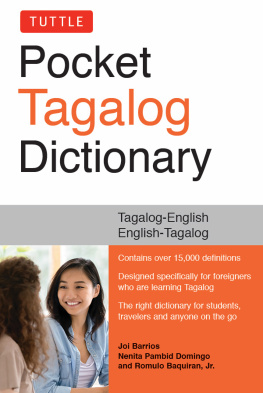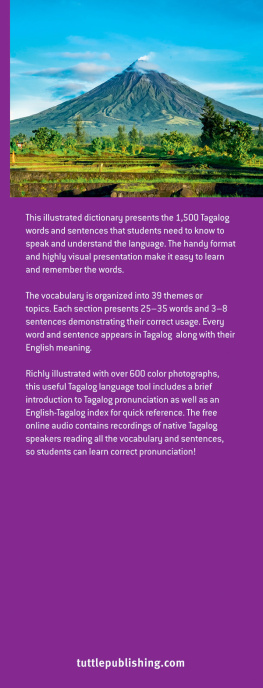Panganiban - Concise English-Tagalog dictionary
Here you can read online Panganiban - Concise English-Tagalog dictionary full text of the book (entire story) in english for free. Download pdf and epub, get meaning, cover and reviews about this ebook. City: Rutland;Vt, year: 1969;2014, publisher: Tuttle Publishing, genre: Detective and thriller. Description of the work, (preface) as well as reviews are available. Best literature library LitArk.com created for fans of good reading and offers a wide selection of genres:
Romance novel
Science fiction
Adventure
Detective
Science
History
Home and family
Prose
Art
Politics
Computer
Non-fiction
Religion
Business
Children
Humor
Choose a favorite category and find really read worthwhile books. Enjoy immersion in the world of imagination, feel the emotions of the characters or learn something new for yourself, make an fascinating discovery.
- Book:Concise English-Tagalog dictionary
- Author:
- Publisher:Tuttle Publishing
- Genre:
- Year:1969;2014
- City:Rutland;Vt
- Rating:4 / 5
- Favourites:Add to favourites
- Your mark:
- 80
- 1
- 2
- 3
- 4
- 5
Concise English-Tagalog dictionary: summary, description and annotation
We offer to read an annotation, description, summary or preface (depends on what the author of the book "Concise English-Tagalog dictionary" wrote himself). If you haven't found the necessary information about the book — write in the comments, we will try to find it.
Concise English-Tagalog dictionary — read online for free the complete book (whole text) full work
Below is the text of the book, divided by pages. System saving the place of the last page read, allows you to conveniently read the book "Concise English-Tagalog dictionary" online for free, without having to search again every time where you left off. Put a bookmark, and you can go to the page where you finished reading at any time.
Font size:
Interval:
Bookmark:
At the start, in 1941, the suggestions and aid of Dr. Eufronio M. Alip proved useful. The interest displayed and the critical suggestions of Rev. Fr. Evergisto Bazaco, O.
P., in the preparation of the letter "A" helped the author to a great extent in finding a "foothold" so-to-speak. When Japan bombed Pearl Harbor on December 8, 1941, the manuscript, completed until letter "C", evacuated with the author to the Barrio of Bungkalot, Tanauan, Batangas. The author's advisers became the old people of the barrio and transient evacuees. From March, 1942, Mrs. Fidela C. de Panganiban, the author's mother; Mrs.
Consuelo T. Panganiban, the author's better-half; and Mrs. Leonila L. Torres, acted as advisers and consultants, although very little work was done. In 1943, back in the city, the author availed himself of the many suggestions and advices of Maj. Jose M.
Hernandez, P. A., Mr. Antonio Zacarias, and Dr. Eufronio M. Alip. In 1944, after an interview with Director Lope K.
Santos of the Institute of National Language, the manuscript (though at this time had reached until letter "M") was revised with a new organization of material. Director Santos and Mr. Julian Cruz Balmaseda provided the author with valuable suggestions at this time. After the first bombing of the Port of Manila by the Americans in September, 1944, the author and Ms family evacuated to Tanauan, Batangas. Work on the manuscript became more intensive. The late Dr.
Brigido Carandang, believed to have been killed by the Japanese early in 1945, made it a habit to look in at the author at work, to read the manuscript and ridicule some entries. The good doctor's ridicule helped the author a great deal in improving the work. When, after 'Christmas of 1944, the Japanese airfield at Lipa and the railroad station at Tanauan became the object of daily air-raids by the Americans, the author and his family evacuated with the manuscript to Barrio Wawang Balili, near Lake Taal, within sight of Taal Volcano and Tagaytay City on the famous ridge of Cavite. Once again, the author had a chance to consult natural "Tagalists", among them the barrio headman Mang Atong Salisi; Mr. Dionisio Atienza, an ex-teacher; and various other persons, natives and evacuees. The manuscript was on letter "S" when the 11th Airborne Division of the U.S.
Army landed paratroops on Tagaytay and the author was called upon by local guerrillas to act as Liaison Officer in meeting the paratroopers. In February, 1945, the massacre of the towns of Santo Tomas, Tanauan, and Lipa, by the Japanese occurred. With thousands of other evacuees, the author, with his manuscript carefully packed under one arm and food for a few days under another, fled across hills and forests to Cabuyao, Laguna, guarded by a guerrilla band captained by the gallant Remigio Maiquis who had the presence of mind to hide under some bushes the Royal typewriter (specially equipped with Tagalog accents) on which the author wrote the manuscript. When the Japanese burned and razed the barrio of Wawang Balili to the ground, among the few things saved from the barrio was the said typewriter. Back in Manila by March, 1945, work on the manuscript was resumed with the constructive suggestions of Mr. Teodoro L. Teodoro L.
Valencia, while the author worked for PCAU 20, and later, for the Military Censorship Detachment, USAFFE. The manuscript was completed by June, 1945. At this time, Mr. Arsenio R. Afan saw the manuscript which had reached over 1, 400 pages. Mr.
Afan was instrumental in interesting Dr. Jose M. Aruego of the University Publishing Company who asked for an abridgment of the work in order to produce a lowpriced vocabulary. The manuscript had to be rewritten, therefore, to meet the requirement of the publishers, and in this preparation the help of Mrs. Antonia H. Villanueva proved very valable.
When, finally, the manuscript went to press, the proofs were gone over by Director Lope K. Santos, Mr. Marcelo P. Garcia, Mr. Leonardo Dianzon, and Mr. Paner. Mrs. Mrs.
Paulina Flores Hidalgo and Miss Aurea Mercado went over the final printed sheets for errata which are corrected in this second printing. As may be seen, hundrds of people had a hand in the preparation of this small vocabulary. To all these people, the author hereby expresses his thanks and acknowledges sincerely their aid, without which this book could not have found itself published in the way it is.
* * *
Kilometer, kilmetr, Sp. Meter, metro, Sp. Decimeter, dosmetro, Sp. Centimeter, sentmetr, Sp. Millimeter, milmetro, Sp. Mile, milya, Sp.
Yard, yarda, Sp. Foot, talampakan Inch, dall B. Surface. Pangibabaw. (Lawak, lak, lapad) Square kilometer, kilmetrng parisukt. Hectare, ektarya, Sp.
Are, arya, Sp. Centare, sentarya, Sp. Square centimeter, sentmetrng parisuk,t. Liter, litro, Sp. Cubic meter, metro kbik, Sp. C. Weight. Bigi. Bigi.
Ton, tunelada, Sp. Quintal, kintl, Sp. Kilogram, kilo, Sp. Gram, gramo, Sp. Centigram, sentgram, Sp. Milligram, miligramo, Sp.
Pound, libra, Sp. Ounce, onsa, Sp. Dram, drakma, Sp. Grain, grano, Sp.; butil. D. Time Measure.
Tagl ng Panahn. Second, segundo, Sp.; saglit, sandal. Minute, minuto, Sp. Hour, oras, Sp. Day, araw. Week, lingg.
Month, buwn. Year, tan. Century, dantan. 2. MONETARY UNITS P 0.01, one centavo, isng pera; isng sntims. 0.10, ten centavos, labing-anim na kuarta; diys. 0.15 fifteen centavos, saikapat-apat; kinse. 0.20, twenty centavos, isng piseta; beinte (in Batangas, isng bilyn). 0.25, twenty-five centavos, kahati. 0.80, thirty centavos, kahat't-wal. 0.35, thirty-five centavos, kahati't-labing-anim. 0.50, fifty centavos, isng salap. 0.60, sixty centavos, tatlng piseta. 0.75, seventy-five centavos, anim na sakapat. 0.80, eighty centavos, apat na piseta. 1.00, one peso, piso. 1.10, one peso and ten centavos, piso't labing-anim na kuwarta. 1.20, one peso and twenty centavos, anim na piseta. 1.25, one peso and twenty-five centavos, sampng sakapat. 1.50, one peso and fifty centavos, tatlng salap. 2.00 two pesos, dalawng piso. 2.50, two pesos and fifty centavos, limng salap. 3.00, three pesos, tatlng piso. 3.50, three pesos and fifty centavos, pitng salap. 10.00, ten pesos, sampng piso. 100.00, one hundred pesos, sandang piso. 3. 3.
NUMERATION is. dalaw, dalw tat. apat. lim. ani. wal. siy. samp. labng-is. labindalaw, labindalw. labintatl. labing-apat. labinlim. labing-anim. labimpit. labngwal labinsiym. dalawamp. dalawamp tis. tatlump. patnap. limamp. sandan. sanda't is. sanda't sam. dalawandan. 1,000 sanlibo. 10,000 sanlaks; sampng libo. 100,000 sangyut; sandang libo. 1,000,000 sang angaw. 1,000,000,000 sanlibong angaw. 1,000,000,000,000 sang-angaw na angaw. 4 NUMERICAL DISTRIBUTION One for each, tigisa. 4 NUMERICAL DISTRIBUTION One for each, tigisa.
Font size:
Interval:
Bookmark:
Similar books «Concise English-Tagalog dictionary»
Look at similar books to Concise English-Tagalog dictionary. We have selected literature similar in name and meaning in the hope of providing readers with more options to find new, interesting, not yet read works.
Discussion, reviews of the book Concise English-Tagalog dictionary and just readers' own opinions. Leave your comments, write what you think about the work, its meaning or the main characters. Specify what exactly you liked and what you didn't like, and why you think so.


